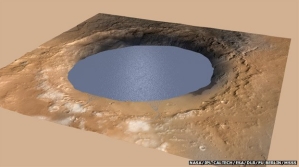
Scientists have announced that based on data transmitted by NASA's Curiosity rover, a lake once filled the 96-mile-wide (154-kilometer-wide) crater on the landscape of Mars.
The findings suggest that the red planet was once suitable for microbial life. According to a Reuters article, the new findings combine more than two years of data collected by the rover since it landed inside the Gale Crater back in August 2012.
"Finding the inclined strata was ... a complete surprise," lead scientist John Grotzinger of Caltech said. "Sedimentary geology ... is the cutting edge for trying to understand the Earth."
Grotzinger added that the rover applied similar techniques used by oil companies to conduct seismic surveys. According to him, the search for inclined strata is important "because then you get geometry that tells you where the rocks are that you're looking for."
Alan Boyle of NBC News wrote that the scenario as depicted by the Curiosity rover suggests that water could have once filled much of the Gale Crater. Also, the 3.5-mile-high (5-kilometer-high) mountain in the middle of the crater, known as Mount Sharp or Aeolis Mons, could have been formed by repeated cycles of sediment buildup and erosion.

Sanjeev Gupta, a member of the science team from Imperial College London, said during a NASA teleconference that the task of reconstructing that geological history of the crater and mountain was akin to putting together a jigsaw puzzle.
"We're now in a position where the jigsaw puzzle is beginning to come into view," Gupta said.
Boyle reported that Curiosity has been making its way southward for months, heading into the foothills of Mount Sharp. Scientists noted that based on readings at a variety of rock formations, the layers of bedrock have a slant consistent with the pattern set by rivers emptying into a large, shallow lake.
"These beds are recording build-out ... of sediment toward the south," Gupta said.
According to Reuters, Curiosity found shortly after landing that Mars once had the chemical ingredients and the environmental conditions needed to support microbial life, which fulfilled the primary goal of its mission. However, scientists do not know how long it took for life to form on Mars and take hold on Earth.
"The size of the lake in Gale Crater and the length of time and series that water was showing up implies that there may have been sufficient time for life to get going and thrive," said Michael Meyer, NASA's Mars exploration program scientist.
Reuters noted that the new studies, which have yet to be published, show a series of wet and dry times at Gale Crater. According to scientists, this finding challenges a previously held notion that the period of warm climate on Mars was early and relatively short-lived.
"All that driving we did ... just didn't get us to Mount Sharp," Grotzinger said of the rover. "It gave us the context to appreciate Mount Sharp."
Meyer noted that this new information from the rover helps lay the groundwork for future missions on the red planet.
"Knowledge we're gaining about Mars' environmental evolution by deciphering how Mount Sharp formed will also help guide plans for future missions to seek signs of Martian life," Meyer said in a news release.







